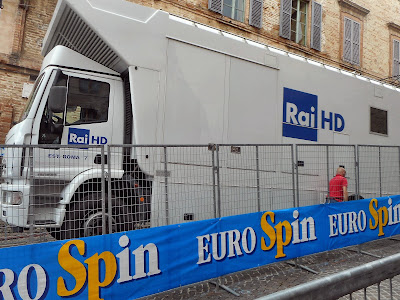The Giro d'Italia...which runs during the month of May each year...is one of three grand tours on the pro racing circuit.
This year's race covers 3,563 km (that's 2,200 miles) over 21 days. It demands top physical condition, because it's like running 21 marathons over three weeks.
This year, Carol and Roger went to Umbria and Le Marche to watch several days of racing.
This blog post, however, is not about bike racing; it's about the incredible logistical challenge presented by such a race.
Towns compete for the privilege of hosting the Giro, because it brings lots of business.
The color of the Giro is pink. It's the color the leading cyclist wears. It's also the color of the paper the Gazetta della Sportiva, the primary sponsor of the race, is printed on.
Towns dress themselves up with pink ribbons and balloons...
The more creative they get, the more media coverage they get.
Millions of people turn out each year to watch cycling's Grand Tours. Not all of them are as fanatical as this fan.
Real tifosi (maniacal fans) turn out hours...or sometimes days...before the race passes by in order to get a prime viewing location.
Their sign reads, "The Giro drives me crazy."
So, what does it take to support a race with 22 teams and 176 riders over 21 different stages?
First of all, somebody has to drive the route early each day and put up route markers, distance markers, sprint points, mountain summits.
Dozens of signs for each stage of the race.
Then, hours before the race passes by, police and tow trucks remove the cars of people who disregarded the signs to clear the race route.
Then, over the final two or three kilometers of the course, race organizers put up hundreds of barriers to keep the tifosi from getting in the way of the final sprint.
After the race, they take down the advertising and the barriers, pack them into a truck, and move on to the next town...so they can do it all again the next morning.
The good news is, spectators don't have to pay watch the Giro.
The bad news is, to get a good viewing spot, a spectator must be on the race route at least an hour before the peloton comes by....and it takes them but a few seconds to whizz past.
Getting a spot near the finish line provides a much more exciting experience, but it's more crowded and hard to see past all the other rubberneckers.
In addition to the eight racers each team has, they bring a small army of support staff as well.
Drivers for the four team cars (One for communications and processing the real-time data from the riders' computers).
The director sportif (coach), two or three mechanics, a chef, a doctor, a physical therapist, a masseuse or two, plus somebody to handle the logistics for all these people.
 |
| courtesy: Giro d'Italia |
When Carol and Roger came to their first Giro, 17 years ago, it was easy to get up close to the racers. One of the other people on their bike tour wanted to get her picture taken with superstar Mario Cippolini. She walked up to his team bus, knocked on the door, and asked for him to come out for a photo. He did.
Not any more. Now the team vehicles are parked in a secure area with guards by each bus. Access is strictly controlled.
There are as many media in the Giro parade as there are team members. RAI, the Italian broadcaster, sent a dozen trucks to cover the race...microwave trucks, satellite trucks, audio and video trucks, plus their mobile control van and broadcast booth.
In the final kilometer of the race, RAI has six cameras.
They have four cameramen on the back of motorcycles and two more in helicopters.
Newspapers and wire services have almost as many still photographers on motorcycles out on the course and at the finish line.
Along with this battalion of technicians there is an equal-sized contingent of print and broadcast reporters.
The man at the right in this picture is a reporter for L'Equippe...the French daily sports newspaper.
Since there's no admission charge to see the Giro, the race organizers have to find some way to raise money. They name sponsors... dozens of them...wineries, breweries, phone companies, real estate agencies.
They all take part in a parade just ahead of the peloton to get the public exposure they paid for. These women get to crawl through every town the Giro visits in the sponsors' caravan, day after day, for 21 days.
Finally, before the peloton passes by, there comes the race director's car...accompanied by a squadron of motorcycle cops...announcing the riders are only seconds behind.
Then the thousands of fans who have been waiting patiently for hours near the finish line pull out their cameras....
...and get a photo like this of the winner of that day's race.
In this case, it was Simon Yates....
but more about that in our next blog post.



















No comments:
Post a Comment